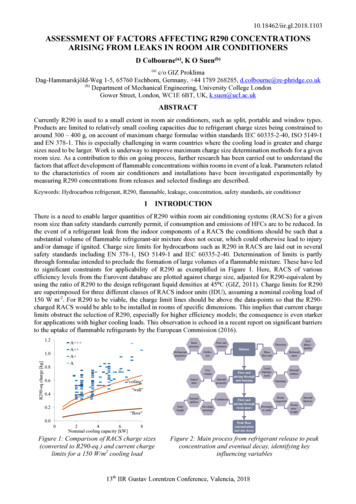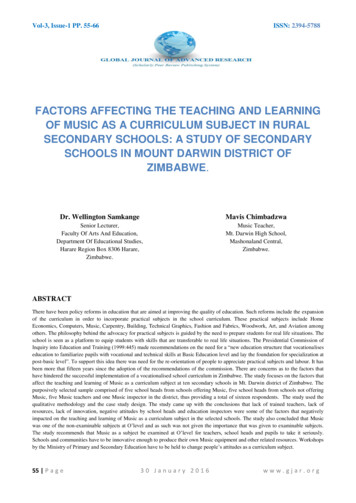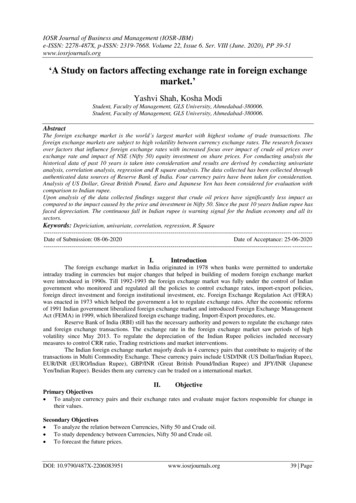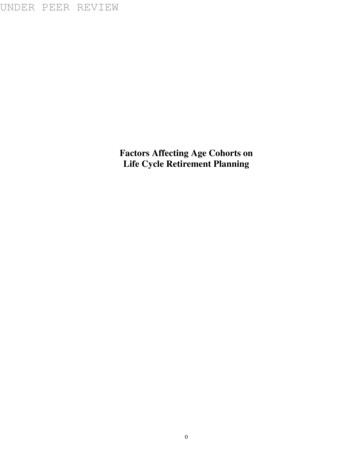
Transcription
10.18462/iir.gl.2018.1103ASSESSMENT OF FACTORS AFFECTING R290 CONCENTRATIONSARISING FROM LEAKS IN ROOM AIR CONDITIONERSD Colbourne(a), K O Suen(b)(a)c/o GIZ ProklimaDag-Hammarskjöld-Weg 1-5, 65760 Eschborn, Germany, 44 1789 268285, d.colbourne@re-phridge.co.uk(b)Department of Mechanical Engineering, University College LondonGower Street, London, WC1E 6BT, UK, k.suen@ucl.ac.ukABSTRACTCurrently R290 is used to a small extent in room air conditioners, such as split, portable and window types.Products are limited to relatively small cooling capacities due to refrigerant charge sizes being constrained toaround 300 – 400 g, on account of maximum charge formulae within standards IEC 60335-2-40, ISO 5149-1and EN 378-1. This is especially challenging in warm countries where the cooling load is greater and chargesizes need to be larger. Work is underway to improve maximum charge size determination methods for a givenroom size. As a contribution to this on going process, further research has been carried out to understand thefactors that affect development of flammable concentrations within rooms in event of a leak. Parameters relatedto the characteristics of room air conditioners and installations have been investigated experimentally bymeasuring R290 concentrations from releases and selected findings are described.Keywords: Hydrocarbon refrigerant, R290, flammable, leakage, concentration, safety standards, air conditioner1INTRODUCTIONThere is a need to enable larger quantities of R290 within room air conditioning systems (RACS) for a givenroom size than safety standards currently permit, if consumption and emissions of HFCs are to be reduced. Inthe event of a refrigerant leak from the indoor components of a RACS the conditions should be such that asubstantial volume of flammable refrigerant-air mixture does not occur, which could otherwise lead to injuryand/or damage if ignited. Charge size limits for hydrocarbons such as R290 in RACS are laid out in severalsafety standards including EN 378-1, ISO 5149-1 and IEC 60335-2-40. Determination of limits is partlythrough formulae intended to preclude the formation of large volumes of a flammable mixture. These have ledto significant constraints for applicability of R290 as exemplified in Figure 1. Here, RACS of variousefficiency levels from the Eurovent database are plotted against charge size, adjusted for R290-equivalent byusing the ratio of R290 to the design refrigerant liquid densities at 45 C (GIZ, 2011). Charge limits for R290are superimposed for three different classes of RACS indoor units (IDU), assuming a nominal cooling load of150 W m-2. For R290 to be viable, the charge limit lines should be above the data-points so that the R290charged RACS would be able to be installed in rooms of specific dimensions. This implies that current chargelimits obstruct the selection of R290, especially for higher efficiency models; the consequence is even starkerfor applications with higher cooling loads. This observation is echoed in a recent report on significant barriersto the uptake of flammable refrigerants by the European Commission (2016).1.2A A A AR290-eq charge [kg]1.00.8BackpressureRefrigerantpropertiesFlow xitphase /qualityDirectionReleaseFlow andmixing throughunit housingMassflow nings"wall"0.40.2"floor"0.00246Nominal cooling capacity [kW]8Figure 1: Comparison of RACS charge sizes(converted to R290-eq.) and current chargelimits for a 150 W/m2 cooling loadEntryheightEnvelopeopeningsFlow andmixing throughroom spaceRoomcongestionProximityto wallsInternalbarriersRoomarea /heightPeak floorconcentrationand mix decayFigure 2: Main process from refrigerant release to peakconcentration and eventual decay, identifying keyinfluencing variables13th IIR Gustav Lorentzen Conference, Valencia, 2018
10.18462/iir.gl.2018.1103The foundations and validity of the current formulae have frequently been questioned (e.g., Corberan et. al,2008; Li, 2014; Vonsild, 2014; Zhang et. al., 2013) and thus highlighting the need to re-examine the previousapproach and assumptions with respect to practical application. To this end, the three main stages that lead upto the formation of a peak floor concentration and the eventual decay of the mixture are identified in Figure 2,along with some key influencing variables that broadly apply to each of those stages. A change in any one ofthese variables could substantially affect the peak concentration. The implications of some of the variableshave been addressed within the wider literature, for example, direction of a release and room ventilation. Forthose that have not, more practical evidence for the significance of their influence is useful for helping developmore inclusive methods for determining charge size limits. Accordingly the purpose of this present work is toexamine the effect of important variables on maximum concentrations and thus maximum charge sizedetermination, and of those to recommend which should be accounted for and how they may be incorporatedin future measures and safety standards.Concerning the measurements presented here, testing was carried out in a 14 m2 laboratory. Refrigerant-gradeR290 was used and supplied through hoses to a suitably sized release orifice or capillary tube to achieve chokedflow. Flow meters and controllers employed include Omega FMA and Alicat MCR with cross-checking ofcylinder weight. Sensors include Honeywell Micropel SR-W-MP75C, IR 2302B1082 and PID S4-W04, withregulator factory calibration and cross-calibration at the start and end of each day of measurements. RACSequipment included three wall and one floor type IDU, all of 8 kW nominal capacity, except for one 2.5 kWwall type.2RELEASE CONDITIONSFigure 3: Comparison of mass flux at choked flow atsaturated vapour pressure corresponding to 25 C forvarious flammable refrigerants and 170R152aR143a0.0R32Theoretical min leak time [min]2.1 Leak mass flow rateAssumed refrigerant leakage mass flow rate is perhaps the most critical of all parameters affecting thedetermination of charge limits. Historically the assumption used the entire charge being released within fourminutes. The basis of this assumption is reported to be a measurement carried out according to a test describedin IEC 60335-2-24 for determining the mass flow rate for a leak simulation test of domestic refrigerators,typically using R600a (Kataoka et al, 2000). This test passed 150 g of R744 through the specified capillarytube and was found to take four minutes and hence a four-minute leak time was established. Such an approachmay be considered entirely invalid since the thermodynamic properties of R744 are completely different fromR600a, R290 or indeed any of the other flammable refrigerants. Figure 3 compares the choked flow mass fluxof R744 and selected flammable refrigerants. R744 exhibits a mass flux about 15 times that of R290 and over40 times that of R600a, implying that the time for the latter two refrigerants to leak out would take substantiallymore time, as reflected within IEC 60335-2-24 that refers to 80% the refrigerant charge being release over onehour. Conversely, if a legitimate worse case leak rate were to be applied then values corresponding to chargemass divided by compressor mass flow rate should be adopted, as presented in Figure 4 for different flammablerefrigerants. Here, the leak time ranges from ½ to 1½ minutes and there is a wide variation amongst differentrefrigerants.Figure 4: Comparison of theoretical minimum leaktime for various flammable refrigerants in RACSCritically, leak time or leak mass flow rate is rather sensitive to the refrigerant type as well as internalconditions (i.e. saturation temperature). They are also contingent upon the leak mechanism and the leak holesize. Thus adopting a single fixed leak time (such as 4 minutes) to cover all refrigerants and conditions is far13th IIR Gustav Lorentzen Conference, Valencia, 2018
10.18462/iir.gl.2018.1103from appropriate, especially given the strong dependency of maximum charge to this assumption. Choice ofleak time or mass flow rate must be carefully considered with respect to the refrigerant type, design andconstruction of the RACS as well as empirical leak data. Practical mass flow rates from real systems have beenpresented previously (e.g., Colbourne et al, 2013; Colbourne and Suen, 2016) along with approximation ofactual potential leak rates based on leak hole sizes from field surveys. Applying those leak hole sizes to thecritical mass flux of the various flammable refrigerants, the “expected” maximum leak rate is in the order of 5to 10 g/min – a factor of about 100 times lower than if the fastest leak times would be used. Adoption of theseexpected leak rates would lead to maximum charge limits in the order of two to five times greater than thosecurrently permitted and the majority of RACS within Figure 1 would be captured by the charge limits.Examples of the influence of leak mass flow rate and released mass on developed concentrations (at the timeof cessation of the release) when the fan is off are given in Figure 5 for an IDU at 0.5 m, 1.0 m and 1.5 m. Forthese measurements, a release was initiated and concentration was measured at sampling points at multipleheights at the centre of the room. Floor level sampling points were monitored once they approached LFL ofR290 the flow terminated and released mass recorded. Figure 5 shows that as mass flow rate diminishes morerefrigerant accumulates in the space between the horizontal plane of the IDU and the floor, allowing a greatermass of refrigerant to be released before LFL across the floor is reached. For the IDUs at higher positions,there is a more clearly defined homogenous layer extending some distance above the floor, before rapidlytransitioning to much lower concentrations closer to the IDU height. Also for the higher IDU the release massflow rate becomes as important as the installation height in determining maximum charge. Figure 6 compilesthe data for all three IDU heights and mass flow rates. As the IDU is installed at higher levels, a greater chargecan be released without reaching LFL at the floor and benefits more from a longer release time.60 g/m, 1.5 m, 800 g2.01000150 g/m, 1.5 m, 430 g30 g/m, 1.0 m, 500 g800150 g/m, 1.0 m, 270 g30 g/m, 0.5 m, 250 g150 g/m, 0.5 m, 115 g1.00.5Mass released [g]Height [m]1.5600400h 1.5 mh 1.0 m200h 0.5 m0.00102030Concentration [g/m3]40Figure 5: Effect of various release mass flow ratefor IDU at 0.5 m, 1.0 m and 1.5 m00510Leak time [mins]1520Figure 6: Effect of release time and IDU height onreleased mass upon reaching LFL at floor2.2 Variable release rateBoth the tests involving concentrations measurements prescribed within safety standards and other studies(e.g., Colbourne and Suen, 2003; Kataoka et al, 2000, Li, 2014; Zhang et. al., 2013) employ a constant releasemass flow rate. This assumption unlikely represents a “realistic” leak scenario, i.e., which may increase overtime due to gradual enlargement of orifice size or which may diminish over time as system charge is depleted.On one hand, leak holes take time to develop; as the orifice area increases over time so will the mass flow(assuming a steady back pressure). Corrosion leaks evolve in the order of weeks, months or years (inferringthat system charge will have been depleted at extremely small rates – 1 g/min – that do not pose safetyconcerns) whereas leaks due to fatigue cracking can develop in minutes; Figure 7 illustrates an example casefor advancing leak rate from severe fatigue cracking, based on a system with 1000 g R290 at 25 C and acompressor rotating at 2900 rpm, using a simple model based on Fleck (1984). On the other, as a leakprogresses boiling of the liquid refrigerant depress the backpressure so mass flow declines (Colbourne andLiu, 2012). An example of decaying leak rate due to an instantaneous 5 mm2 hole at condenser outlet on anR410A window AC is shown in Figure 8, where the system had been off for 24 hours and also moments afterthe system had been continuously operating. In the former, a gradual decrease can be noted. In the latter case,the hot compressor imposes a higher saturated vapour pressure but prevents significant absorption ofrefrigerant in the oil, resulting in a higher initial flow rate and also a much steeper decay. Time for large holeto develop can be faster than time for charge to deplete with such a large hole – so it is probably reasonable toassume an instantaneous hole in parts of the system that are vulnerable to fatigue cracking. Depending on theparticular circumstances, the variation in mass flow over time will consist of an increase as the hole size13th IIR Gustav Lorentzen Conference, Valencia, 2018
10.18462/iir.gl.2018.1103develops and eventually a decay as the system pressure declines, with a middle period of steady release forwhich the duration depends upon hole size and pressure.mass flow rate [g/min]250mass lost [g]1201000200600150400100200500246Time [min]8After operation8060402000024 hour off100800Mass flow rate [g/min]300Mass discharged [g]Mass flow rate [g/min]Overall, two cases may be identified. For “small and medium” leaks, it is reasonable to assume a fairly constantleak rate where the middle period accounts for the majority of the mass leaked. For “large” leaks, the decayperiod (e.g., Figure 8) is dominant as the leak hole must have developed due to mechanisms that cause nearinstantaneous holes (such as external impact or fatigue cracking). Such flow rate profiles may lead to differentmaximum concentrations following a release of a certain mass.-510Figure 7: Approximated leak mass flow rate of R290at the initial period of fatigue crack in pipe10254055Time [mins]7085100Figure 8: Measured instantaneous release mass flowrates from a window ACFigure 9 and Figure 10 show floor concentrations with IDU fan off, arising from a rising release mass flowprofile (broadly mimicking that in Figure 7) and a decaying release profile (as in Figure 8), respectively, andFigure 11 is a reference case using a constant flow rate. All tests involved a 300 g release of R290 over tenminutes from IDU right hand return bends at a height of 1.0 m. Whilst the test in Figure 11 used a constant 30g/min, the variable mass flow tests used six increments of 50 g at mass flow rates ranging between 10 g/minand 100 g/min in 15 g/min graduations.Concentration [kg/m3]0.06#1: 1m in front, 1m high#1: 1m in front, 1m highTest no. 40#4: 0.5m in front, floor#5: 1m in front, floor#5: 1m in front, floor#6: 1.5m in front, floor0.020.06#6: 1.5m in front, floor0.0409:23:0209:27:22Figure 9: Rising release rateaveraging 30 g/min for 10 mins0.0015:50:24Test no. 37#3: beneth unit, floor#4: 0.5m in front, floor#5: 1m in front, floor0.06#6: 1.5m in front, floor0.040.020.0209:18:43#1: 1m in front, 1m high0.08#3: beneth unit, floor#4: 0.5m in front, floor0.040.0009:14:240.08#3: beneth unit, floorConcentration [kg/m3]Test no. 32Concentration [kg/m3]0.0815:54:4315:59:0216:03:22Figure 10: Decaying release rateaveraging 30 g/min for 10 mins0.0014:38:2414:42:4314:47:0214:51:22Figure 11: Constant release rateof 30 g/min for 10 minsResults show three substantially differing concentration profiles. Rising leak rate shows gradual concentrationrise until the maximum value. Decaying leak produces a significant initial “jump”, which for most samplingpoints represents the peak concentrations for the entire test. With both the variable leak rates, average floorconcentration changes significantly over the test duration, compared to a relatively minor change with the fixedleak rate. Overall, the two variable rate cases produce a substantially higher maximum concentration than thefixed leak rate, although whilst the peak maximum is about the same for both yet the average maximum valuefor the decaying release rate is 10% lower than that of the rising release rate. This is due to the short periodwhere the mass flow rate is several times higher than the constant 30 g/min case. Particularly for the decayingleak, the initially high leak rate seems to dominate the subsequent floor concentration. Concentration at 1 mabove floor level supports this, as it is significantly lower than in the other two cases, where the higher massflow occurring latterly seems to shunt more of the mixture from the floor upwards.13th IIR Gustav Lorentzen Conference, Valencia, 2018
10.18462/iir.gl.2018.11032.3 Release phaseHitherto, most contributions to this subject have used vapour only releases. Primarily this is because theexperimental procedure is much easier and mass flow can be controlled more consistently. Furthermore – atleast for smaller RACS, “real” simulated leaks (i.e., from systems) have found that even if a release is createdfrom a liquid or two-phase pipe, there is usually intermittent or cyclic “spitting” of liquid for the first tenth ofthe release duration and is then followed by continuous vapour.Mean floor conc [g/m3]60504030Vapour- max- minTwo-phase- max- min20100010203040Time [s]506070Figure 12: Comparison of average, maximum andminimum floor concentrations for vapour and twophase release of 100 g/min from IDU at 1.0 mA number of tests were carried out in order todiscern any significant difference between vapouronly and two-phase where R290 was released at 100g/min at the right hand return bends of an IDUpositioned 1 m above the floor when IDU fan is off.Sampling points were located on the floor at 1 mincrements away from the IDU. Refrigerantcylinder was cooled to about 0 C, the supply hoseinsulated and then cooled with liquid R290 to avoidpre-boiling of the liquid at the start of the test. It isestimated that the vapour fraction of the two-phaserelease during the test was 0.25.Example results for averaged floor concentrationare shown in Figure 12. Whilst the vapour releasetends to create faster rate of concentration riseinitially, concentration development for the two-phase release tends to be more gradual and the finalconcentration is also marginally lower. This more gradual rise is likely due to the delay caused by thevaporisation of the liquid droplets. Average maximum concentration after a 120 g release is approximately10% higher for the vapour-only release. In addition the variation across floor concentrations is substantiallywider for vapour releases ( 11 g/m3) than for the two-phase release ( 6 g/m3). Overall two-phase releasesseem to lead to more homogenous distribution, which is probably due to the additional convection generatedby the flashing liquid and additional thermal gradients.3UNIT HOUSING3.1 Use of diffuserUnder quiescent conditions, entrainment of surrounding air into a jet or plume of dense refrigerant is stronglyinfluenced by its momentum; a high velocity jet into free air can easily result in near-homogenous mixingwithin the space whereas a low velocity descending negatively buoyant plume will often establish a stratifiedlayer on the floor (e.g., Webber et al., 2011). Recognising that almost all refrigerant-containing parts of RACSare encased to some extent, it is reasonable to assume that any leak will impinge upon an immediate surface,thus reducing momentum from the jet and leading to a plume sinking from the IDU. Development of theformula for maximum refrigerant charge within IEC 60335-2-40 employed a so-called “diffuser” device in anattempt to mimic this situation, where the release is fed through a sort of packed inverted funnel such that theexit velocity is in the order of millimetres per second (Kataoka et al, 2000).Whether a diffuser suitably mimics a release from an IDU was examined by simulating releases from both adiffuser device and from within an IDU and comparing floor concentrations. Each test presented here used 310g released at a constant 60 g/min via a 2 mm diameter capillary tube at various positions and orientationswithin the IDU (Figure 13), which was fixed 1.5 m above the floor and sampling points were positioned acrossthe floor. Results for maximum mean floor concentration and “peak” concentration are given in Figure 14.Highest concentration amongst all of the releases originating from the base of the IDU right hand return bends.Crucially this is a fraction of the measured concentration using the diffuser. Values for all positions at the leftor right return bends are comparable, whereas releases within the coil block and from the connector fitting areconsiderably lower. Implication is that the available internal volume within which the release can freely premix before sinking out of the IDU has a strong effect on floor concentrations.13th IIR Gustav Lorentzen Conference, Valencia, 2018
10.18462/iir.gl.2018.1103Base of lefthand returnbendsCoil base,Inside centre just insideof coilbaffleCoil top,Base ofjust insideright handbaffle return bendsmax meanRHS ret bends, base, uppeakRHS ret bends, baseRHS, coil baseRHS coilCoil centreLHS ret bends, baseRear conn fittingConnector fitting, withinrear voidDiffuserBase of right handreturn bends, upwardsFigure 13: Comparison of theoretical minimum leaktime for various flammable refrigerants020406080Max concentration [g/m3]100Figure 14: Comparing peak concentrations due toreleases from positions within IDU and diffuserFurther tests were carried out to broaden the assessment of differences between use of a diffuser and a realIDU (with fan off), by varying release mass flow rate and release height but maintaining a fixed release positionwithin the IDU at the base of the right hand return bends (since it led to the highest floor concentration). Figure15 presents results for the diffuser only, with the outlet positioned at 1.0 m and 1.8 m, and results for the IDUat the same heights in Figure 16. Findings from Figure 14 are replicated, where across all release heights andmass flow rates, the diffuser produces approximately double the peak and maximum mean concentration thanwith the IDU. The wider difference between peak and max mean values for the diffuser is due to the axialvariation throughout the plume not having had sufficient decent distance to become more homogenised. Thisis not seen with the IDU release because homogenisation has already occurred through mixing within theenclosure.1.0 m (peak)1.8 m (peak)1201.0 m (peak)1601.0 m (max mean)1.8 m (max mean)80400Maximum concentration [g/m3]Maximum concentration [g/m3]1601.0 m (max mean)1.8 m (peak)1201.8 m (max mean)80400020406080Mass flow rate [g/min]100120Figure 15: Floor concentrations arising fromdiffuser releases020406080Mass flow rate [g/min]100120Figure 16: Floor concentrations arising fromreleases at IDU coil return bends3.2 Outflow concentrationsFurther insight to the condition of the mixture exiting the IDU is useful as it helps clarify the differencesbetween releases from diffusers and IDUs. An IDU was prepared with several frusta sealed to the opendischarge grille, extending downwards for 0.5 m so as to channel all refrigerant-air mixture that pours fromthe base. Addition casing was attached around the perimeter of the inlet grille to collect any mixture spillingout of the top opening. Sampling points were positioned at the base of each channel of the frusta. R290 wasreleased at different constant mass flow rates from the base of the right hand return bends (with fan off).Average concentrations for each of the mass flow rates at each successive linear location along the dischargeopening are given in Figure 17, with the release position indicated by an arrow. (Corresponding graph for theinlet opening not shown.) Figure 18 summarises those results and also for the mixture flowing out of the topinlet opening. Local data in Figure 17 shows a significantly higher proportion of the mixture exiting closer tothe release point than at the opposite end of the IDU (about 40 times higher at 10 g/min) but as release rateincreases, a more even distribution develops (e.g., only four times higher at 100 g/min). It may also be notedthat the direction of the release also has an influence on this distribution. For example, other tests (not shown)with a different release orientation (but same location) resulted in the pattern in Figure 17 being reversed,13th IIR Gustav Lorentzen Conference, Valencia, 2018
10.18462/iir.gl.2018.1103where highest values occurred at the opposite end of the IDU; the momentum of the jet “pushed” the refrigerantaway from the immediate openings. As seen in Figure 18, not-insignificant quantities of refrigerant migrateout of the top (inlet) of the IDU, once there is sufficient volume of refrigerant vapour to act against the negativebuoyancy of the mixture within the IDU; this observation was found computationally in previous work(Colbourne and Suen, 2014). Refrigerant mixture must only be flowing upwards from a proportion of the inletopening area given that fresh air must be simultaneously drawn downwards through the opening it to enablethe mixture to flow from the base (exit). Importantly, this phenomenon should assist with the dilution mixingprocess as it increases the area of the plume-air interface. Figure 18 also includes data for a 2.5 kW IDU, whichhas an internal volume one-third of the 8 kW. Concentration at the 2.5 kW IDU outlet (for the same mass flow)is notably lower than the 8 kW yet two to three times higher at the inlet (top) opening. A higher ratio of R290volume flow to internal enclosure volume means more gas is forced out of the top; this lower overall exitingconcentration infers reduced values at floor (with same mass flow).160mass flow [g/min]1008 kW e exit conc [g/m3]Concentration [g/m3]1008 kW inlet802.5 kW outlet2.5 kW inlet604020001.010Length [m]Figure 17: R290 concentrations at different massflow rates along IDU discharge opening length2030Release mass flow [g/min]4050Figure 18: Average concentration of R290 exitingIDU4040303020T&B: 180cm2T: 540/B: 180 cm210T&B: 540 cm2Max floor conc [g/m3]Max floor conc [g/m3]3.3 Unit housing geometryTo help understand the effect of IDU housing geometry on developed concentrations, a mock IDU wasconstructed to enable certain characteristics to be varied. External dimensions were 0.54 m long and 0.26 m 0.26 m cross-section, with options to vary opening areas at the top, base and side, internal enclosure lengthand internal free volume. R290 was injected horizontally into a small compartment to mimic the voidassociated with coil return bends, the volume and baffle area of which was also changeable. Throughout themass flow rate was fixed at 70 g/min with 200 g and with the enclosure fixed at 1.0 m above the floor andagainst a wall panel. No forced airflow was applied.75% BA, 720 cm275% BA, 360 cm275% BA, 180 cm290% BA, 360 cm250% BA, 360 cm2Hollow data-points indicate freevolume reduced by packing; "BA"refers to baffle area ratio2010"T" refers to top opening area;"B" bottom opening area00%20%40%60%80%100%End baffle area ratio, relative to cross-section [%]Figure 19: Effect of baffle area and top and baseopening area on maximum floor concentration00102030Internal free volume [litres]40Figure 20: Effect of internal free volume and totalopening area on maximum floor concentrationFigure 19 compares maximum concentration moments after cessation of the release across a range of end baffleto cross-sectional area ratios; a high ratio means that the end section is almost closed off and so restrictsmigration of the refrigerant to the rest of the enclosure volume. Generally, the more open the path is betweenthe void containing the release and the remaining part of the enclosure, the better the pre-mixing appears to bebased on lower floor concentration. Three sets are shown according to the area of the top (T) and bottom (B)13th IIR Gustav Lorentzen Conference, Valencia, 2018
10.18462/iir.gl.2018.1103openings; again, more dilution of the initial release occurs with larger openings. The influence of IDU freevolume is presented in Figure 20, along with baffle area ratio and opening area (equally divided between topand bottom). For fixed baffle area ratio and opening area, the effect of internal free volume on maximumconcentration appears negligible. However, when the free volume is reduced by means of internal packing(whilst enclosure volume is fixed) there is a notable increase in maximum concentration. Whether or not freevolume is displaced with internal packing, both reduced baffle area ratio and increased opening area helpreduce floor concentrations.4ROOM SPACE4.1 IDU location with respect to wallConcentration measurements are typically carried out in empty rooms, with IDUs positioned centrally againstone wall so as to be as symmetrical as possible and improve repeatability. In theory, a more pessimistic releaseposition should be the corner of the room, inferring that the available surface area for plume entrainment wouldinitially be reduced and thus higher concentrations. Measurements were made using a release of 440 g at 100g/min from the right hand return bends of an IDU at 1.0 m above the floor and positioned at three alternatelocations. Figure 21 compares concentrations at cessation of the release for the same unit being positioned atthe mid-point of a “short” wall (3.3 m), mid-point of a “long” wall (4.6 m) and in the corner (against the longwall). There is variation of about 10% of the average maximum floor concentrations across the threepositions, with the IDU at the corner leading to highest values and the short wall position giving the lowest.For the corner position, the plume spread at floor level is more constrained thus limiting dilution, whereas forthe short wall position, the plume is given the longest flow path, likely to aid dilution. Having said this,consideration must also be given to the fixed position of the
10.18462/iir.gl.2018.1103 13th IIR Gustav Lorentzen Conference, Valencia, 2018 ASSESSMENT OF FACTORS AFFECTING R290 CONCENTRATIONS ARISING FROM LEAKS IN ROOM AIR CONDITIONERS D Colbourne(a), K O Suen(b) (a)c/o GIZ Proklima Dag-Hammarskjöld-Weg 1-5, 65760 Eschborn, Germany, 44 1789 268285, d.colbourne@re-phridge.co.uk





![05[2] Strategy competitors, competitive rivalry .](/img/2/052-strategy-competitors-competitive-rivalry-competitive-behavior-and-competitive-dynamics.jpg)




